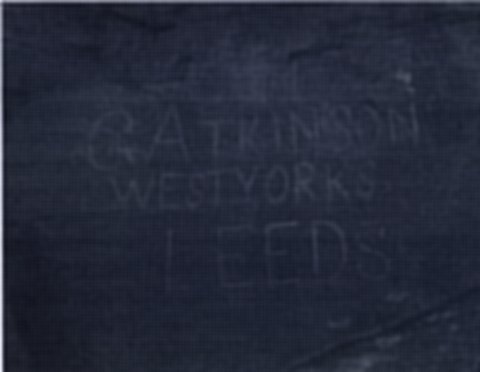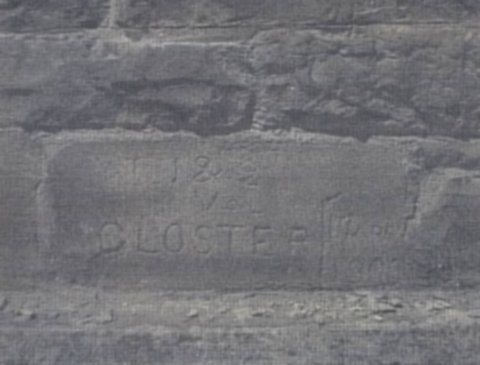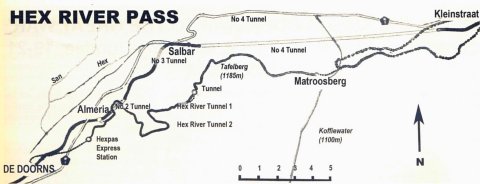

 The South African
The South African
Some years ago, during a tour with Mr Stephaan Jordaan* along this section of railway line between De Doorns and Matroosberg Stations on 26 September 2007, I took the opportunity to inspect certain features with military connections from the Anglo-Boer War period. As I was the only tourist that day, Mr Jordaan kindly took me in his 4x4 vehicle for the full tour along the Spoornet service roads; we started at De Doorns and progressed in an easterly direction up the line.
First Cutting
In this cutting are numerous graffiti incised on the large rocks on the north side. The clearest ones read 'G ATKINSON WEST YORKS LEEDS' and '9271 PT L DANUEL M E MULLAN WEST YORKS BIEAK [?]'. These two men are clearly from the West Yorkshire Regiment and Danuel appears to have included his rank (Private). In response to my request, the Museum and Archives of the Prince of Wales's Own Regiment of Yorkshire sent me a huge amount of material relating to the West Yorkshires' service in South Africa, including copies of two lists showing the name '5196 Atkinson G' as being entitled to the Queen's South Africa Medal with Bar 'Cape Colony' and the King's South Africa Medal with bars 'South Africa 1901' and 'South Africa 1902'; this appears to be the 'G ATKINSON' amongst the graffiti. They were unable to trace the other names.

Another document sent by the Regiment was The Record of the 4th Battalion West Yorkshire Regiment (Prince of Wales Own) during the Boer War 1899-1902 by Captain A B Ritchie (Seaforth Highlanders), Adjutant 4th Batt, 63 pages, published in York in 1903. It is interesting to note that the 4th Battalion West Yorks was a Militia (ie volunteer) Battalion, and the author emphasizes that Militia were brought to South Africa specifically for the purpose of guarding lines of communication, to release the regular troops for fighting further north; this ties in with the presence of the Gloucestershire Regiment at Second Cutting, also volunteers (see following section). Ritchie's very comprehensive account contains the following references to the 4th Bn West Yorkshire Regiment's service in the Hex Pass area:
2 July 1900: Soon after their arrival in Cape Town, 'A and 'B' Companies were moved to Tunnel Siding and 'C' Company to De Doorns. Any of these units could have supplied the detachment that guarded First Cutting. The author comments: 'Headquarters and the various detachments were now busily employed in guarding bridges and posts - the duties at Tunnel Siding being most onerous and important; if the Boers could have destroyed any part of the line at Tunnel Siding, all means of communication by this route to the army northwards would have been stopped for a very considerable time, and if the enemy had succeeded in holding the Hex River Pass, which was their original idea, a very different complexion would have been put on the face of existing hostilities, and the passage of the British troops northwards by this allimportant route would have been completely barred.'
1 April 1901: 'Major Tottie [Commandant of Laingsburg district] handed over his command to Captain Metcalfe-Smith, 4th West Yorks, and proceeded to Tunnel Siding in command of "C" and "F" Companies with Lieuts Lamb and Grant Dalton - a defensive position with the aid of native labour was now formed.'
18 May 1901: Major Tottie, in command of 'A, 'E' and 'F' Companies at Worcester, 'left a guard at Tunnel Siding, which was controlled from Worcester. It will be noticed that the Battalion had still sole charge of the very important Pass .. .'
In Part II of the account, which details the 'Record of the Detachments' under the headings of different officers, the author states that on the same date 'Tunnel Siding Camp was dismantled, and Major Tottie took his detachment to Worcester .. .' I find this statement rather strange but, if one reads the two statements together, it seems to indicate that Tottie believed the threat had lessened to the extent that a big camp at Tunnel Siding was no longer necessary and sending a detachment by rail from Worcester was sufficient; if one considers the next entry, he may well have had cause to regret his decision, but by then he was Station Commandant at Hermon, much further back along the line. However the story of the Anglo-Boer War in the Cape Colony frequently highlights the problem of scarcity of men and the commanders were constantly moving troops around this huge area and juggling their resources.
23 July 1901: '[T]he Boers began a southern movement, threatening Worcester and Ceres Village, and Hex Mountain Pass ... Troops were hurried down under Colonels Crabbe and Wyndham, and the usual precaution of standing to arms before dawn - men sleeping with arms and ammunition by their side - was again reverted to.'
23 August 1901: The list of locations and strengths where detachments of the 4th Battalion were stationed, extending from Hermon to Kimberley, includes 'Tunnel Siding .. 43 other ranks'.
20 February 1902: Cape Colony District Orders announce 'The 4th West Yorkshire Regt is held in readiness to embark for England.'
1 March 1902: The greater part of the 4th Battalion embarked at Simonstown to return home, their place being taken by fresh drafts of volunteer units.
(I am greatly indebted to Major M L Sullivan, Museum and Archive Curator, and Graham Dyson, Assistant Curator and Archivist, in York for taking the trouble to send me this data, which has enabled new light to be shed on this subject.)
Second Cutting
This cutting has reasonably clear graffiti on rocks of the low retaining wall on the south side of the track, reading 'T 1 &2 VOL GLOSTER MARCH 1900' and, on the next rock to the right, '5 PL SER COY TO FIGHT THE BOERS'. 'T' could refer to 'Troop' (although infantry regiments normally have 'Sections', the term 'Troop' being confined to cavalry regiments and Royal Horse Artillery). 'VOL' refers to the fact that these men belonged to a Volunteer Active Service Company, 'GLOSTER' is the abbreviation for the Gloucestershire Regiment, 'PL' is short for Platoon, 'SER COY' refers to 'Service Company'. (I am grateful to Douglas Robertson, a visitor to the line from the UK, for his research which discovered some of these interpretations.)
On the crown of the koppie on the north side of the cutting there are remains of a large complex of fortifications, including several ring walls forming forts with different aspects over the lower ground to the north and covered passages linking them. The whole complex is in a very deteriorated condition as the walls are built of shale- or slate-like rock, apparently without mortar, and seem to have been subjected to vandalism by railway workers or visitors over the last century; it is impossible to make out a plan of the works without much clearance work.

To the south of the cutting, I had time to undertake only the briefest inspection due to time considerations and this large area would repay more detailed examination. In the time at my disposal, I was able to identify two rectangular forts close together and overlooking the lower exit from the cutting, both measuring roughly 6m x 4m and rather better preserved than those to the north of the cutting, and a raised platform above the upper fort; I took GPS readings at the upper fort which gave the co-ordinates as S33° 26' 57.6" E19° 44' 09.7" and the height above sea level 755m. At the rear of this area I climbed up the rocks to the next level where I noted straight away an excavated 'rifle pit' lined inside with walls of small rocks, but backfilled to the top with rocks.

Fort above two tunnels
It was only after we had inspected the military structures on Kata Kisu Reserve that I learned that there was also a fort above the tunnels. By that time it was too late to turn back to see it.
Large bridge over river to east of Tunnel Station
To the south-east of this bridge and at a much lower level, I inspected a rectangular fort built of larger rocks and measuring approximately 8m x 3.5m internally; the walls are 1m thick and stand to about 1.2m high externally, and the entrance is at the north corner (towards the bridge). The GPS co-ordinates of this fort are S 33025' 48.9" E 191> 46' 02.9" and the height above sea level 833m.
General comments
This was a particularly interesting day's excursion and, as always in these cases, time is insufficient to cover all the ground. These military structures, although not in a pristine condition, are of considerable interest and require further research. Preliminary to calling in an archaeologist to find and classify the artifacts on the various sites, it will be necessary to obtain permission to clear fallen rocks and remove invasive and obscuring vegetation from the ground both inside and outside the buildings, so that the ground can be properly examined; this will also have the advantage of clarifying the original layout of the buildings. I do not recommend restacking rocks on the existing walls, as this gives a false impression of their condition and one cannot be certain how high the walls were originally.
The various fortifications that I have seen are fairly typical of the standard of work that one finds with structures built by the British infantry regiments during the Anglo-Boer War, constructed from necessity and also to keep the troops busy; and there are probably considerably more of them surviving than have been found to date. The best workmanship is generally found in forts and blockhouses built under the supervision of Royal Engineers officers; and forts built by local Town Guards and District Mounted Troops can also be quite neat, as evidenced by those which I have recently recorded built by the Town Guard around Montagu. All are part of the history of South Africa and of our national heritage.
* Mr Jordaan was a grape farmer in the Hex Valley. When trains were diverted to the new, improved route through the Pass in 1989, the old track was abandoned. Mr Jordaan approached South African Railways when they started to remove the electrical infrastructure and asked them to leave the track in place between de Doorns and Matroosberg stations, as he wished to use it as tourist attraction employing push trolleys drawn by a converted Fordson tractor. SAR agreed and Jordaan's tours commenced. Sadly, Stephaan Jordaan died a couple of years ago, but the tours continue under family leadership.
Return to Journal Index OR Society's Home page
South African Military History Society / scribe@samilitaryhistory.org